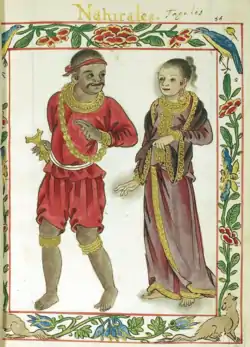Cainta (Baybayin) | |||||||||
|---|---|---|---|---|---|---|---|---|---|
| unknown–1571 | |||||||||
| Status | Barangay state | ||||||||
| Common languages | Old Tagalog, Old Malay | ||||||||
| Government | Feudalism under Barangay state | ||||||||
| History | |||||||||
• Established | unknown | ||||||||
• Conquest by Spain | 1571 | ||||||||
| Currency | Piloncitos, barter rings,[1] barter | ||||||||
| |||||||||
| Today part of | Philippines | ||||||||
| Part of a series on the |
| Pre-colonial history of the Philippines |
|---|
 |
| See also: History of the Philippines |
In early Philippine history, the Tagalog bayan (Kapampangan: balen; "country" or "polity")[2] of Cainta was a fortified upriver polity that occupied both shores of an arm of the Pasig River. It was located not far from where the Pasig River meets the Lake of Ba-i and is presumed to be the present site of the municipality of Cainta, Rizal.[3]
Description
Descriptions of early chroniclers say that the polity was surrounded by bamboo thickets, defended by a log wall, stone bulwarks, and several lantakas, and that an arm of the Pasig River flowed through the middle of the city, dividing it into two settlements.[3]
As described in an anonymous 1572 account documented in Volume 3 of Blair and Robertson's compiled translations:[3]
This said village had about a thousand inhabitants, and was surrounded by very tall and very dense bamboo thickets, and fortified with a wall and a few small culverins. The same river as that of Manilla circles around the village and a branch of it passes through the middle dividing it in two sections.
History
Siege of Cainta
When the Spanish forces of Miguel López de Legazpi first established the city of Manila in 1571, Cainta was one of the surrounding polities that went to Manila to negotiate for friendship with Manila. However, Cainta's envoys noted the small size of Legazpi's forces and decided to withdraw their offer of friendship since Cainta was a fortified polity that was perfectly capable of defending itself.[3]
In August 1571, Legazpi assigned his nephew, Juan de Salcedo, to "pacify" Cainta. After traveling several days upriver, Salcedo laid siege to the city and eventually found a weak spot on the wall. In the final Spanish attack, over 400 residents of Cainta were killed, including their leader, Gat Maitan.[3]
Dissolution
Cainta was established as a visita (annex) of Taytay on November 30, 1571, under the administration of the Jesuits.
List of rulers
| Title | Name | Specifics | Dates | Primary sources | Notes |
|---|---|---|---|---|---|
| Gat | Maitan | The chief of Cainta | d.1571 | 1572 account documented in Volume 3 of Blair and Robertson's compiled translations: [3] | the last ruler of the fortified city |
See also
References
- ↑ "Piloncitos: The Treasure of Philippine Numismatic". Filipinonumismatist. Archived from the original on April 25, 2017.
- ↑ "Pre-Colonial Manila". Presidential Museum and Library. Archived from the original on March 9, 2016. Retrieved April 27, 2017.
- 1 2 3 4 5 6 Blair, Emma Helen; Robertson, James Alexander, eds. (1903). "Relation of the Conquest of the Island of Luzon". The Philippine Islands, 1493–1898. Vol. 3: 1569–1576. Translated by Gill, J. G. Ohio, Cleveland: Arthur H. Clark Company. p. 145.
